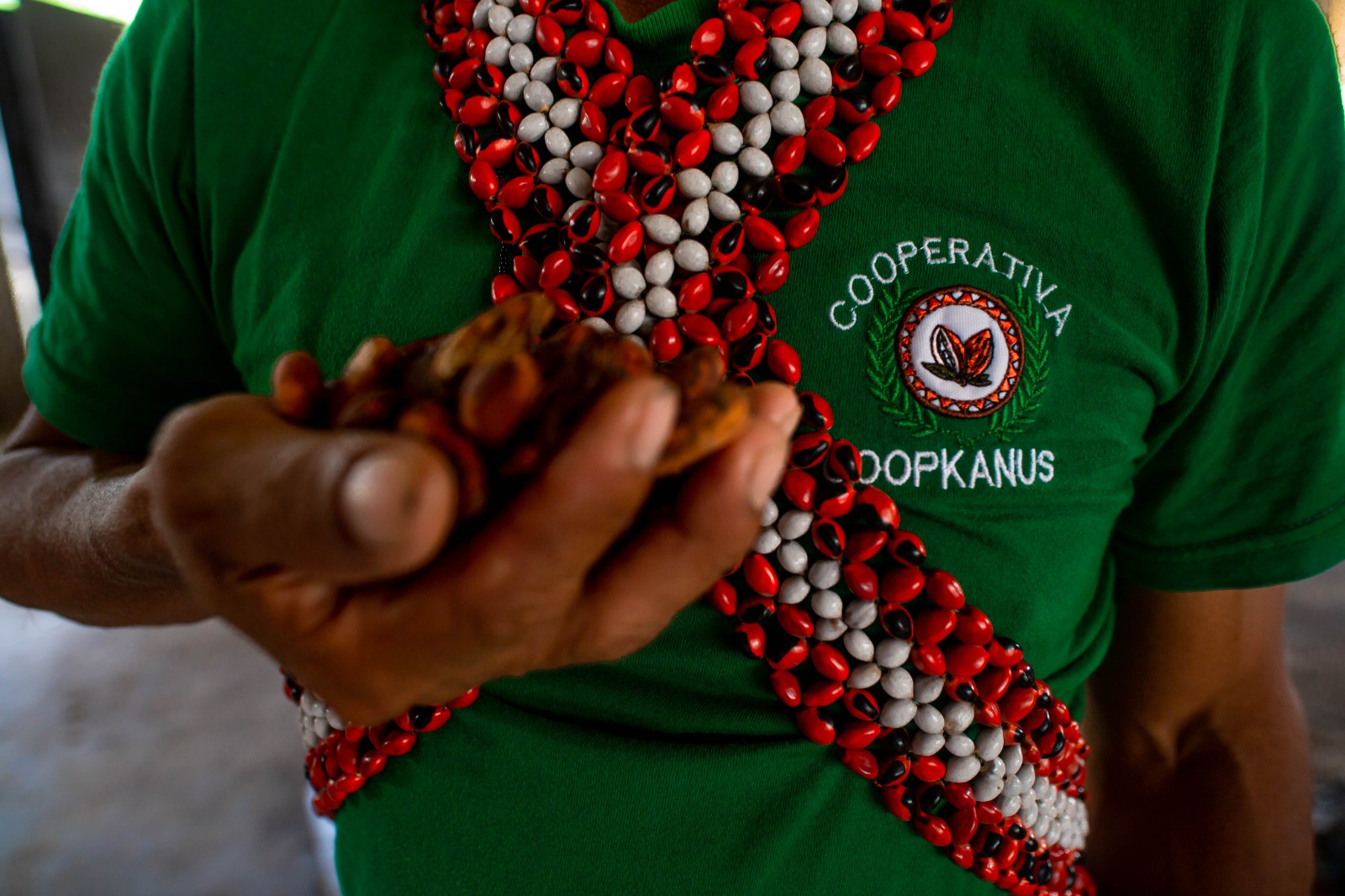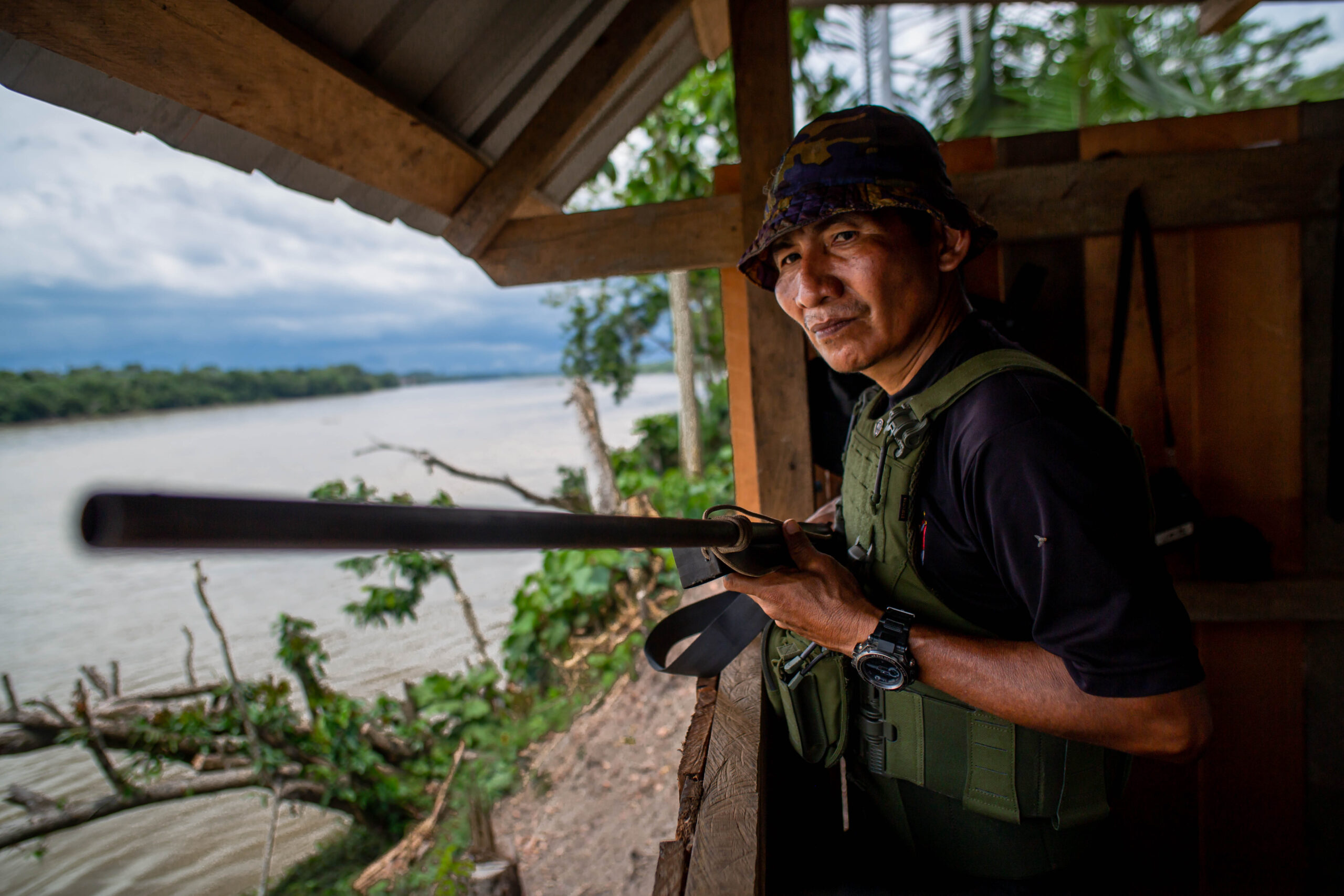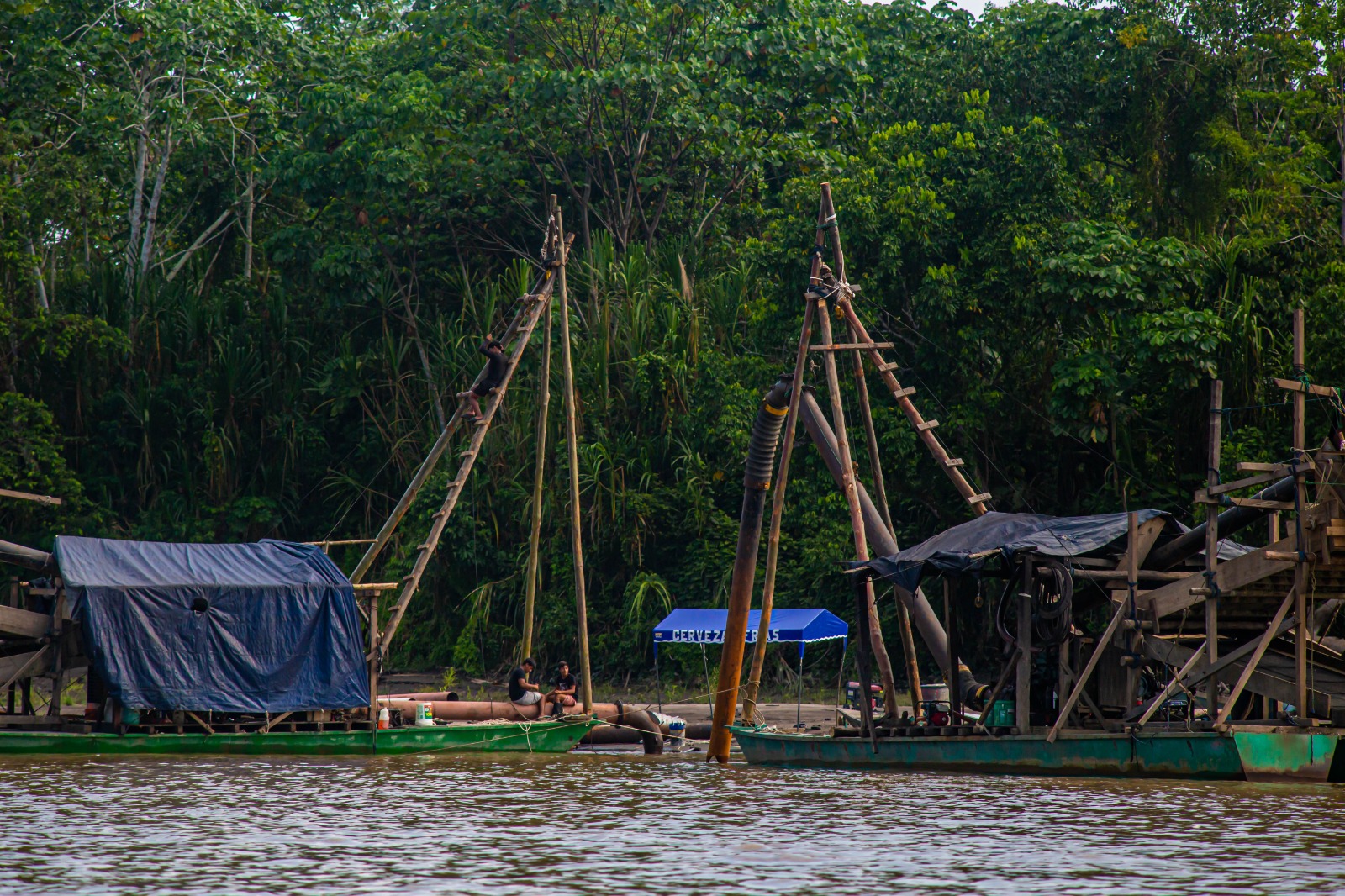- The Wampís Indigenous people of northern Peru have spent decades resisting the expansion of oil drilling and other extractive projects in their Amazonian territory.
- In 2015, they became the first Indigenous group in the country to declare themselves an autonomous nation.
- While this has led to some positive results in the form of security and conservation work, the Wampís lack the resources to develop productive initiatives and expand guard posts across their 1.3-million-hectare (3.2-million-acre) territory.
- The state has not recognized the autonomous nation, a requirement for the Wampís people to receive direct funding from the state and international donors.
In 2015, leaders of the Wampís did what no other Indigenous peoples have done in Peru’s modern history: They declared themselves an autonomous nation to gain greater control over their territory.
For decades, the Indigenous Wampís (or Huambisa) of the northern Peruvian Amazon have protested against oil drilling and other extractive activities in their home, to little avail. By declaring autonomy, they sought to change this. A decade on from that declaration, now in 2025, they’ve seen rays of success. But the Wampís still find themselves vying for control over their land.
The chief hurdle is that the Peruvian state won’t recognize their sovereignty, say Pamuk Teófilo Kukush Pati and Tsanim Evaristo Wajai Asamat, the elected leader and the justice director, respectively, of the Autonomous Territorial Government of the Wampís Nation (GTANW). The pair were at London Climate Week in June to discuss the importance of their autonomy, self-determination and self-governance with business leaders, policymakers, investors and civil society representatives.
“The [Peruvian] state has little interest in our autonomy, but we want to be recognized,” Teófilo told Mongabay during an interview in a small room at the back of London’s Royal Anthropological Institute. He was wearing traditional Wampís garments with utsupak (chest pieces) and tawas (multicolored feather crown).

Without this recognition, the autonomous nation has struggled to develop local development and conservation initiatives, such as monitoring posts for its land guardians or poultry farms, as it still depends on the state or intermediaries, like NGOs, to handle funding from donors, sources said.
“Without legal recognition, the only way to access international funding is through allied NGOs or by establishing an NGO themselves,” Roger Arturo Merino Acuna, an associate professor at the University of the Pacific in Lima, told Mongabay by email. But the Wampís “do not seek to organize themselves as associations or civil society organizations,” and instead “seek to have their organization as peoples with collective political rights recognized by the state.”
Unlike in Bolivia and Ecuador, neighboring Amazonian countries that also have large Indigenous populations, the concept of an autonomous nation doesn’t exist in Peru’s Constitution. That means the state isn’t legally obligated to recognize them. Instead, prevailing laws recognize their right to their collective property, customs and jurisdiction in internal disputes, but not their control of natural resources, which is what the Wampís are seeking.
For decades, the Puerto Rico-sized Wampís territory — 1.3 million hectares (3.2 million acres) straddling the departments of Amazonas and Loreto — has been threatened by oil activity, illegal mining and logging. To combat these threats amid a lack of state support, the nation has formed an Indigenous territorial guard named Charip, meaning “lightning.” The nation has also created several income-generating and conservation projects, such as a turtle recovery initiative. Some of these projects are already yielding positive results.
Though their situation is difficult, leaders said, it’s much different from where they found themselves years ago.
The sparks that ignited a nation
In 2008, the Peruvian government issued a series of special decrees, 1015 and 1073, to open up vast swaths of Indigenous territory for resource exploitation. That triggered protests by hundreds of Indigenous Wampís and Awajun people in August of that year. In April 2009, the protesters began a 50-day road blockade at the entrance to the city of Bagua in Amazonas. That action is considered by researchers to be one of the most significant protests in recent Peruvian history.
According to Amnesty International, nine demonstrators and 24 police officers were killed as security forces tried to stop the peaceful blockade. At least 169 demonstrators and 31 police officers were also injured and at least 79 people were arrested.

The state eventually repealed the decrees and launched new legislation that made it the state’s duty to consult Indigenous peoples before the approval of any projects that might affect them. But the threat to their lands and rights didn’t end there, the Wampís leaders said.
Over the last 30 years, the Wampís have repeatedly resisted government efforts to exploit Block 64, an oil field located in Morona district, Loreto. Wampís authorities told Mongabay they were never consulted about this project and, therefore, based on the country’s consultation law, it should never have been approved. Oil spills have also become a regular occurrence, smothering riverbanks in black sludge and contaminating the water that the local communities drink.
The Wampís people’s formal complaints to Peru’s environmental protection agency OEFA, have often been ignored, Indigenous leaders told Mongabay. Oil interests have also led to social conflicts among community members, Teófilo added, with some Wampís and Achuar people in favor of the oil companies.
Peru’s Ministry of Energy and Mines didn’t respond to Mongabay’s requests for comment by the time of publication.
“That attack by the state through laws and oil concessions was one of the reasons for forming an autonomous government, because believing ourselves to be [autonomous] — that is, proclaiming ourselves as such — strengthens us much more than when we are alone,” Evaristo said. “What we seek is for the state to listen to us before making any decisions that may affect us.”
The building of a nation
Before speaking at an event in London on climate finance mechanisms, Teófilo and Evaristo told Mongabay that the Wampís model for territorial governance is based on Tarimat Pujut, or buen vivir, the concept of living well in harmony with nature. All decisions ultimately stem from this philosophy.
“Our ancestors relied on the river, respected the forest and fed themselves with unpolluted fish,” Teófilo said. “That’s why our ancestors lived for years because there was no pollution and they lived full lives.”
The Wampís declared themselves autonomous in 2015 and delivered their constitution to the Peruvian Congress in 2017. But their plans to use Tarimat Pujut as a platform to articulate their demands for self-determination, territorial governance and natural resource management began much earlier, in the 1990s. It was their way of saying no to projects that threaten their territory, culture and forests.
“The state, from the capital city of Lima, granted authorization for mining, oil, timber, and other resource concessions without our knowledge,” Gerónimo Petsain, the autonomous nation’s territorial manager, told Mongabay by text message. “We were directly affected by the pollution and other problems. Therefore, we decided to form a single nation to be able to claim the defense of our territory, not as federations — but as a nation.”
The group’s decisions are made by consensus, with community assemblies serving as the highest decision-making bodies within the nation’s government structure, according to Paul Codija, an anthropologist from the School for Advanced Studies in Social Sciences (EHESS) in Paris. This relies on assembly practices and procedures for reaching agreements that are quite different from those found in the parliaments of liberal democracies, Codija told Mongabay by email.


“The Wampis assembly is not conceived as a space where representatives of political parties, with already established ideas and programs, confront one another,” he wrote. “Rather, it is understood as the place where opinions and collective will are produced and shaped together.”
Teófilo told Mongabay that the nation’s goal is not to form another country that’s independent of the Peruvian state. “What we seek is to have a voice in political decisions,” he said. “So far, [the state] hasn’t done anything. It hasn’t done anything concrete or told us ‘OK, let’s do this,’ or ‘How do you want to achieve this?’ There’s no dialogue.”
The absence of the state has been an environmental and social problem for a long time, Teófilo said, especially in issues related to security. In recent years, there’s been an expansion of illegal gold mining in the Wampís territory, which has led to impacts for communities, such as water pollution.
Although their nation had been years in the making, it was on Feb. 18, 2024, when Wampís leaders decided to take matters into their own hands.
Between independence and dependence
That year, Indigenous authorities formed the territorial monitoring group Charip to combat the invaders themselves.
Two months later, Charip arrested three Peruvian policemen for their involvement in illegal gold mining near the Wampís community of Villa Gonzalo, on the banks of the Santiago River. A high-level commission from the Peruvian government visited the Wampís Nation a few days later and promised to eradicate illegal mining in the area. But sources told Mongabay that the state still hasn’t fulfilled its commitments.

Nine community members are part of the monitoring group, which has been set up with guard posts, internet connection, bulletproof vests and night-vision goggles. René Santiago Ti, the Charip president, told Mongabay by video call that his members operate with few resources. When the group was formed, it had about 60 personnel to fight against illegal miners, Ti said, but this number has plunged because the work is unpaid and the members have families they need to provide for.
“The comrades who left, it’s not that they don’t want to be here — they do,” Santiago said. “But they have families. And those who are active feel forgotten by the state. Those who are firmly active here are truly committed. Without food and money we fight.”
Among the efforts they carry out on their own, the Wampís have developed several local development and conservation initiatives, including poultry farms and a turtle recovery program. Some projects have been more successful than others, the leaders told Mongabay, in part due to the lack of recognition by the state, which has hindered their ability to receive direct support from funders.
The turtle recovery program, which has led to positive results so far, was created after populations of yellow-spotted Amazon river turtles, also known as taricaya (Podocnemis unifilis) and Arrau turtles, or charapa (Podocnemis expansa), both a source of food for the Wampís, began to decline due to unsustainable local harvesting and water pollution caused by illegal mining.
Since 2022, with the support of U.K.-based advocacy group the Forest Peoples Programme (FPP), several Wampís communities have been trained in how to conserve and protect the two turtle species. Alfonso Flores, the nation’s director of environment and nature, told Mongabay by voice message that members of the community collected thousands of eggs from the wild and placed them in prepared nests that were then replanted on seminatural beaches to hatch safely.
“Lately, I have been seeing taricayas on the street and I counted 150 of them basking in the sun on the bends and in all the pools of the upper Morona River,” Flores said. “During my latest [field] trip, I counted many more. This means they are increasing.”
During 2023 and 2024, almost 4,500 yellow-spotted Amazon river turtle hatchlings and close to 1,000 Arrau turtle hatchlings were released into lakes across the Morona River, the FPP has reported.
Teófilo told Mongabay by phone that the nation has provided fences and materials to some communities to raise poultry, but this project hasn’t produced any results. He said this is because of the nature of the funding they receive from international donors, which comes with a prepackaged project design and inflexible criteria.
“Often, the needs are very different in each Indigenous community,” Teófilo said. “I feel that’s why most projects don’t have a positive impact, because [Indigenous peoples] don’t design it, but rather, it is designed from above. Maybe that’s not true, but that’s the feeling that exists.”
The main objective now is to continue conserving the land and their culture, and to live in tranquility, “free from threats, diseases and noise,” Alfonso said. He and others are teaching the nation’s youth the importance of Tarimat Pujut, while other leaders seek funding to expand Charip control posts and local initiatives.
“This is how we want to see our young people,” Santiago said. “In peace, growing up with good intentions, with a clear conscience and healthy. That’s all we want.”
Peru’s Ministry of Culture and the governments of Amazonas and Loreto departments didn’t respond to Mongabay’s requests for comments by the time this article was published.
Banner image: A member of the Charip territorial monitoring group inside a monitoring post. Image courtesy of Maria Goretii/Convoca.
An Indigenous-led solar canoe initiative expands across the Amazon
Latest Mongabay podcast episode: To save humanity and nature we must tackle wealth inequality, says Cambridge researcher. Listen here:
Citations:
Farah, A. B. (2025). After the flood: expansion and retreat of Indigenous autonomy and environmental justice. Latin American and Caribbean Ethnic Studies. doi:10.1080/17442222.2025.2498804
Merino, R. (2021). Buen vivir and the making of Indigenous territories in the Peruvian Amazon. Latin American Perspectives, 48(3), 136-151. doi:10.1177/0094582X211004896
Feedback: Use this form to send a message to the author of this post. If you want to post a public comment, you can do that at the bottom of the page.
